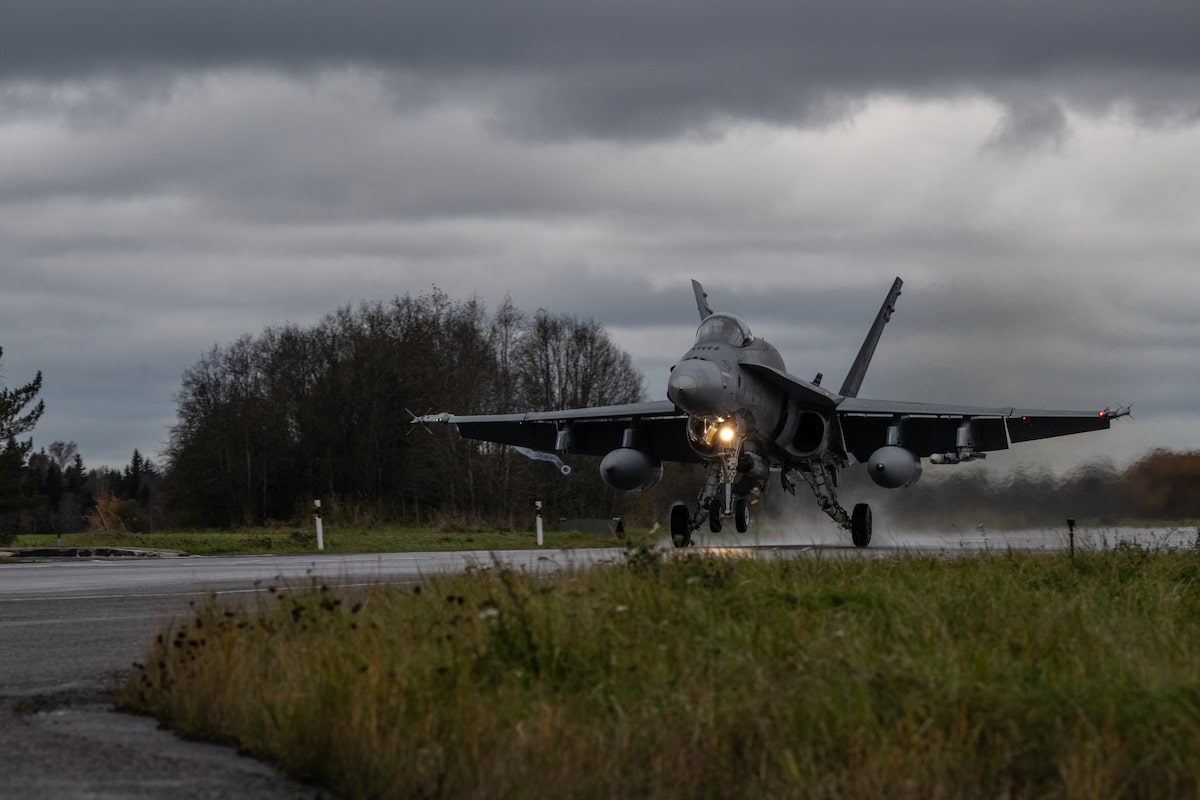Canadian CF-18 Hornet pilots practised complex aircraft manoeuvres on Estonia’s Jägala-Käravete Highway as preparation for operating in more austere locations.Supplied
Canadian fighter jets landed on an Estonian highway for the first time, marking a key milestone in NATO’s efforts to boost allied air forces’ ability to operate under hostile conditions and make them harder to strike in the tense Baltic region, the Royal Canadian Air Force says.
The mission was carried out as part of the international Tarassis 25 military exercise this week, where Canadian CF-18 Hornet pilots practised complex aircraft manoeuvres on public roads that had been closed to traffic – as preparation for operating in more austere locations in case airfields or airports are damaged during conflicts, rendering them unusable – alongside their Italian and Estonian counterparts.
Russian drones over Europe could be a ‘psyop’ – or preparations for a wider war
The Tarassis event was organized by the Joint Expeditionary Force (JEF), a U.K.-led coalition of 10 countries which also includes Denmark, Finland, Iceland, Latvia, Lithuania, the Netherlands, Sweden, Norway and Estonia. The rapidly deployable force operates in support of NATO, complementing its security measures in Northern Europe. Canada, as a NATO member, was invited to participate as a partner nation, which also shares strategic relevance and geographic interest with the JEF.
“Tarassis is designed around scenarios that reflect real-world challenges to rehearse a series of rapid, prepared response options such as protection of an airfield, patrolling a sea lane or reinforcing a participating nation,” a JEF statement said.
In the last year, NATO refined its operational focus areas to five priorities that guide planning, training, resource allocation and the execution of military operations. One of them is agile combat employment, which involves dispersing aircraft across multiple, often improvised, bases rather than relying on a single one. These deployments were practised during the Tarassis exercise.
Colby Badhwar, an analyst at the Ukraine-focused research group Tochnyi, explained that this approach has become a strategic necessity in the face of more technologically advanced long-range weapons and has been witnessed extensively in Ukraine.
“Operating your aircraft solely from a limited number of military airbases gives the enemy the opportunity to neutralize them with long-range strike weapons at the outset of conflict – dispersed operations complicates the enemy’s planning as there’s now a nearly unlimited number of locations your aircraft can launch from,” Mr. Badhwar said.
The expert added that leveraging two of NATO’s strong points – logistics and air power – through dispersed operations allows the military alliance to counter one of Russia’s: the magnitude of the long-range firepower it can generate.
Canadian jets have on multiple occasions contributed to NATO missions in Europe.Supplied
Several civilian and military airports were among the initial targets Russia destroyed within the first days of launching its full-scale invasion of Ukraine in 2022. Video footage has shown that the Ukrainian Air Force has continued to operate its F-16s from dispersed airfields, frequently relocating them to keep the Russians guessing. Ukrainian fighter jets can also be observed flying at very low altitudes to evade enemy radar systems in videos circulating online.
Reducing the time jets spend in a known location, concealing their emissions (radios, data links or transponders), and providing backup capacity, all contribute to making detection and targeting harder for an attacker.
Low-altitude flying was another skill set rehearsed by allied forces during the training drill, as it is important for a variety of mission types, including in some cases air policing.
Air policing operations are essential in detecting, monitoring and intercepting unidentified aircraft or potential aerial threats. While NATO maintains air policing units in Europe, notably in Lithuania, Estonia and Romania, it does not have detachments in North America. Instead, this role is filled by NORAD, the joint aerospace defence command between Canada and the United States.
NATO leaders express alarm over growing Russian hostility after drone incursion in Poland
This year, Canada’s CF-18s have been primarily focused on Arctic monitoring, including recent patrols triggered by Russian aircraft detected near the continent. However, Canadian jets have on multiple occasions contributed to NATO missions in Europe, such as intercepting a Russian Su-27 near Romanian airspace in 2020 during Operation Reassurance.
The number of similar incursions has ramped up in recent months, part of a “wider pattern of increasingly irresponsible Russian behaviour,” General Alexus Grynkewich, NATO’s Supreme Allied Commander Europe, said during a recent briefing.
Last month, in a single day, two violations took place: Three armed Russian MiG-31 aircraft violated Estonian airspace for more than 10 minutes, and two Russian jets flew at low altitude over the Polish Petrobaltic drilling platform in the Baltic Sea, breaching its security zone.
In the latter incident, NATO fighters responded and forced the aircraft to withdraw. Operating at minimal heights may sound easy, but experts say it is a highly complex manoeuvre to master for pilots.
“The margins for error are so much smaller – because of the speed of the aircraft and proximity to the ground, microseconds matter and mistakes cannot be recovered at low altitude like they might be when flying higher,” said Mick Ryan, senior fellow for military studies at the Australia-based Lowy Institute.
This year, NATO launched initiatives to strengthen protection against low-level aerial threats, defined as systems operating below 150 metres. To overcome enemy advanced radar detection, the alliance is reassessing low-altitude flying and radar-evading tactics, as showcased in the Tarassis exercise.
